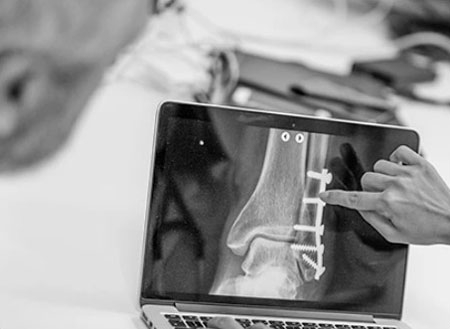
If you were a fly on the wall of an orthopedic office, you may hear acronyms tossed around like alphabet soup with no idea as to what any of it means. In the realm of fractures, one of the most common acronyms is an ORIF or an Open Reduction Internal Fixation procedure. When a fracture comes to our office for evaluation, clinical decision-making by our board-certified physicians determines whether or not the fracture requires surgical intervention. Sometimes fractures are treated conservatively with immobilization that allows the bone to re-mold itself in a controlled and stabilized environment. Other times the fracture is deemed unstable and displaced, and your surgeon may determine that you would benefit from an ORIF procedure.
Most commonly, patients fracture the fibula bone in their ankle or the radius bone in their wrist; however, bones all over the body can be fractured in such a way that an ORIF is
beneficial for proper healing and maintaining function down the line.
Upon deciding that an ORIF surgical procedure is the best option, your surgeon will unfold a treatment plan that spans the course of about three months. Every surgeon and every fracture is a little different; therefore, every treatment plan will have quirks specific to your particular case. The most common regimen starts with immobilizing the fracture in a splint prior to surgery to prevent any further displacement or damage from taking place and to help control pain. Your surgery will be scheduled, likely at The Orthopaedic Surgery Center attached to our main clinic building, within a week, depending on how much swelling is present.
During your surgery, your doctor will make a small, carefully placed incision over the site of the fracture and dissect the soft tissue to reveal the bone. The bone will then be ‘reduced’ or placed back into proper anatomical alignment. At that point, hardware will be utilized to keep the newly-aligned bones in place while your body heals the fracture over the next several months. The hardware used in these procedures involves some combination of small metal plates, screws, and pins. An intraoperative x-ray will be taken to confirm proper bone and hardware alignment prior to ending the case. At the end of your procedure, you will be placed in a special postoperative splint similar to what you had prior to surgery.
You will come back to our clinic approximately ten days after surgery to have the splint and dressings unwrapped, the stitches removed, x-rays taken, and a cast, brace, or boot applied. The degree of immobilization after an ORIF depends on your surgeon, the type of the fracture, and the bone involved. An ORIF of the ankle will either be placed in a short leg fiberglass cast or a pneumatic walking boot; whereas, a wrist ORIF will be placed into a short arm cast, an over-the-counter removable brace, or a specially-made brace fashioned by our occupational therapists. After a time period of immobilization or controlled gentle range of motion, you will follow-up again for repeat x-rays and evaluation. At this visit, your doctor will discuss progressing your weight-bearing status, range of motion, and strength. Depending on your case, a home exercise plan or formal physical therapy will be initiated.
Once you have begun to use that body part more normally for about six weeks, your surgeon will want to see you one more time to make sure that normal function has been achieved. Your strength and motion will be tested. The hardware will stay in place, but if it becomes problematic, it could be removed later. Assuming all goes well, it is at this point in the journey that we give you permission to flee the nest! We are always available if problems arise, but we encourage you to return to normal activity as that is our goal in orthopedics!
This blog is written by one of our very own-Morgan. She is a certified athletic trainer working as a medical assistant with our providers each and every day in our clinic. She obtained a bachelor's degree in athletic training from Carroll University in Waukesha and a master's degree in Kinesiology from Michigan State University. She is excited to bring you updates and information about the happenings at OAW.

